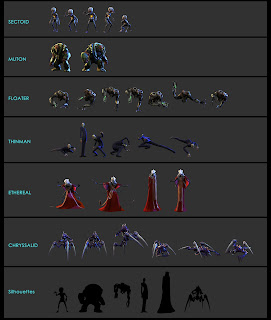Time for a brief lesson in Sectoid eye physiology. These creepy, grey skinned horrors look upon the world through huge alien eyes that neither move or have pupils. Giant, shiny orbs possessing a translucent third eyelid. Who knows what goes on in their minds? When they point their heads in your direction, rest assured, they DO see you.
Here is a blink animation I made while trying to figure out how this third eyelid would work:
Friday, December 21, 2012
I Could Hardly Contain Myself
Alien Containment was one of my babies in this game. At least as far as the Muton, Sectoid, and Ethereal are concerned. This was a rare opportunity to do some hand-keyed creature animation that could be presented with a cinematic flare. What fun! The turn around on these animations was insanely fast, but I can say with a smile that the monstrous effort was worth it. The ideas for what each character would be doing had to be simple given the time frame, but also be rewarding to watch. I didn't want to phone these in, and was imagining some XCOM fan at the tail end of a grueling mission wanting to interrogate this live alien they just acquired. The moment needed to be satisfying and special.
Here are some play blasts of my animation ideas:
Here are the final containment animations I did in context:
After animation was done a lot of love was added via the Base modeling team, and our Cinematics Lead. Just the right level of sweetness in my opinion.
It's always important, especially when you have no time, to focus on the important storytelling moments you want to hit and focus on those. You can be the judge of whether I did a good job or not, but the intention was to get across the caged animal aspect of alien containment, show the characters personalities, and show in a non-gratuitous way the finality of the aliens situation. This is their last stop before the autopsy table after all.
Here are some play blasts of my animation ideas:
Here are the final containment animations I did in context:
After animation was done a lot of love was added via the Base modeling team, and our Cinematics Lead. Just the right level of sweetness in my opinion.
It's always important, especially when you have no time, to focus on the important storytelling moments you want to hit and focus on those. You can be the judge of whether I did a good job or not, but the intention was to get across the caged animal aspect of alien containment, show the characters personalities, and show in a non-gratuitous way the finality of the aliens situation. This is their last stop before the autopsy table after all.
Ready...Aim...FIRE!!!
One enjoyable aspect of my production life on XCOM: Enemy Unknown was the teams need for cinematic ideas. This ranged from large Tentpole cinematics to simpler moments when you're in the XCOM Base and something interesting happens. Pitching ideas is always fun for the team, and every once and a while I had the time to pre-vis a rough story board for one of these.
Here is an example from when a player first gets his/her Laser and Plasma weapons:
A very simple illustration of new tech the player just acquired, and an attempt at making that moment feel rewarding. Some of these ideas stuck and ended up in the final game. The camera placement, and decisions on what each character is doing during the shots is obviously fleshed out later.
I'm a huge fan of taking the time to explore ideas cheaply before any real time is committed to modeling, animating, etc. You don't get much cheaper than storyboards considering how quick and easy it is to iterate on any given idea.
Here is an example from when a player first gets his/her Laser and Plasma weapons:
A very simple illustration of new tech the player just acquired, and an attempt at making that moment feel rewarding. Some of these ideas stuck and ended up in the final game. The camera placement, and decisions on what each character is doing during the shots is obviously fleshed out later.
I'm a huge fan of taking the time to explore ideas cheaply before any real time is committed to modeling, animating, etc. You don't get much cheaper than storyboards considering how quick and easy it is to iterate on any given idea.
Tuesday, November 6, 2012
What's In A Pose?
If a picture is worth a thousand words then it stands to
reason that a character’s pose speaks volumes. The entire art team paid
close attention to this during all phases of production for "XCOM: Enemy
Unknown." Particularly a character’s silhouette and whether it
retained graphical clarity while the character was in motion. We wanted
the player to easily identify, and distinguish between the palette of human and
alien characters. This sort of "at a glance" approach helped us
to create more iconic characters. All of our animations tried to play
into this as well. Providing distinctive personalities, and movement
types into each character.
I had a blast exploring the plethora of alien personalities, and body types that make up our game.
The image below shows a few of the poses I made
during the early “round robin” stage of our character exploration. One or two are poses taken from cinematic I worked on. Usually the animation team would have a list of “states” needed for the characters and it would
be up to us to make these as cool and functional as we could. There was a lot of back and forth between animation, concept, and modeling to really nail the physical form of each character. Specificity in the look for each character was a top priority. The
animation team would sit down as a group to make as many poses for a given
character as we could think of. We’d usually do this in a morning posing
session. We’d put all the poses side by side and pick the strongest ones,
or combine ideas between poses to arrive at something iconic. These poses
had to be resolved early on because so much animation work gets influenced by
them.
I had a blast exploring the plethora of alien personalities, and body types that make up our game.
Pitching A Winning Combat System
Video Game Design by it's very nature requires iteration upon tireless iteration. This can be both an ugly and a beautiful thing. In the case of "XCOM: Enemy Unknown" it was beautiful. Early on we realized that simply bringing the classic XCOM gameplay back with updated graphics wasn't going to cut it. Taking cues from games with amazing combat systems like Uncharted, Gears of War, and Red Dead Redemption, we decided a more dynamic action approach was necessary.
Thus was born COMBAT 2.0!
What's any idea without a proper pitch movie I ask? An idea without a strong foundation!
When this idea first came up the animation team decided to create a memorable pitch to illustrate what we believed the gameplay had the potential to look and feel like. We combined cinematic sensibilities with the needs of design and necessary player information.
Watch it here:
Much of what we proved with this movie made it into the final game.
Here is a playblast of some of the "Rookie" soldier animations that were used:
Thus was born COMBAT 2.0!
What's any idea without a proper pitch movie I ask? An idea without a strong foundation!
When this idea first came up the animation team decided to create a memorable pitch to illustrate what we believed the gameplay had the potential to look and feel like. We combined cinematic sensibilities with the needs of design and necessary player information.
Watch it here:
Much of what we proved with this movie made it into the final game.
Here is a playblast of some of the "Rookie" soldier animations that were used:
Thursday, October 11, 2012
Laying It All Out
I was one of the first guys on the team for the X-COM pitch
cinematic. While our 2-D animatic and
hero characters were being made I was busy laying out our set, and building low
poly proxy models for all the objects and spaces our characters were going to
exist in and interact with. I then
placed cameras that closely matched the storyboards and 2-D animatic. This allowed us to figure out the scale of
our world, test out our 2D ideas in a 3D space, and create an environment for
early animation tests. The modelers were
then able to very efficiently remodel everything in high poly using my models
as a template.
Creating this low poly set did not take much time, and paid
dividends further in the pipeline since a lot of problems had been figured out before
any really expensive work was done.
Everyone could focus on making a visually stunning cinematic.
Take a look at this layout page showing my early low poly set, and stills of the finished set from the final movie.
Pitching A Winning Strategy Game
Every success story has a beginning. XCOM: Enemy Unknown's involved a small team of incredibly passionate artists that wanted to make a statement about where strategy gaming could go. So we made a movie. Half of the shots in this were animated by me, and I will have another post showing some of the process that went into their creation.
Watch it here:
X-COM Pitch Movie Credits
Watch it here:
X-COM Pitch Movie Credits
Lead Artist – Greg Foertsch
Lead Animator – Dennis Moellers
Animators – Justin Thomas
Kevin Bradley
Kevin Bradley
Modelers – Chris Sulzbach (Hero Soldier/high poly set)
Brian Mahoney (Furniture/Room Deco)
Brian Mahoney (Furniture/Room Deco)
Ryan Murray (Sectoid/Sectopod)
Bryce Homick (items in bedroom)
Nathan Gordon (truck/shotgun)
Justin Thomas (low poly set
model/layout)
FX Animators – Brian Feldges
Mike Bazzell
Concept Artist – Piero MacGowan
Sound – Roland Rizzo
Mark
Cromer
UI Artist – Steve Ogden
These are the people responsible for creating the original
pitch movie for the game “X-COM: Enemy Unknown.” This pre-rendered cinematic was created over
a four month time frame from January to April in 2008. A handful of us had
started preliminary work in December of 2007.
It represents our vision for the “X-COM” remake we wanted to develop. Originally we wanted the title to be simply “X-COM”
but that idea changed over the course of development for many reasons.
Little did we know that we were embarking on a nearly five
year development journey that would push us harder, and bring us closer as a
team than any other title previously developed at Firaxis Games.
I feel privileged to have had such a large involvement with
its creation.
Subscribe to:
Comments (Atom)



